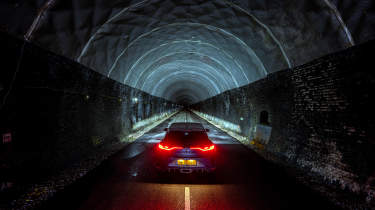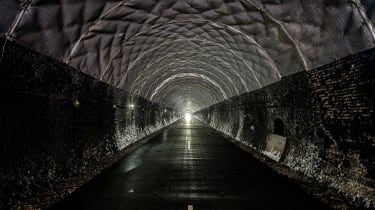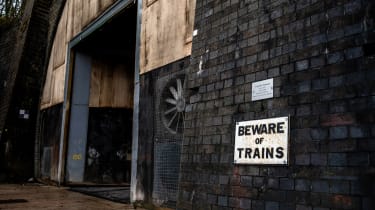An unlikely wind tunnel facility in Northamptonshire – Catesby Tunnel
Testing sites for car manufacturers can often take them to the ends of the earth, or under it in the case of the UK’s latest wind tunnel
Some of the finest asphalt in the UK can be found in a Victorian railway tunnel in Northamptonshire. Just a few weeks ago the final 2.7km of black stuff was laid in Catesby Tunnel by a company that usually surfaces race circuits, creating a unique test facility. Originally built in the 1890s to speed goods and people to London by rail, Catesby Tunnel was abandoned in the 1960s but has now been restored and repurposed by a group called Aero Research Partners Limited (ARP) primarily as an affordable alternative to traditional wind tunnel testing, though it could be put to may more uses.
Buried some 30ft below the surface and absolutely straight, the tunnel offers consistent temperature and humidity while its new surface was laid in one continuous flow and has no joins or seams and no bumps bigger than 3mm. According to Jon Paton of TotalSim, a Computational Fluid Dynamics and applied aerodynamics company and partner on the project, Catesby offers fine resolution and repeatability. Paton says it would be able to show the difference between the standard, slightly raised enamel bonnet badge of a Porsche 911 and the transfer badge beneath the lacquer used on some RS 911s.
Tiny gains like this add up to better efficiency for lower energy consumption in production cars and lower lap times in competition cars, and it’s work that’s usually carried out in a wind tunnel and sometimes outside, though that struggles to deliver repeatability. Here in the UK, the only available wind tunnel is in the Midlands at Horiba MIRA and as well as dating back to the ’60s it doesn’t feature a moving road. For UK vehicle manufacturers and race teams, accessing a rolling road wind tunnel involves shipping cars, parts and staff to European wind tunnels at considerable cost. Catesby Tunnel, conveniently located a few miles south of Daventry, Northants, aims to offer an affordable alternative.
Rob Lewis, MD of TotalSim, says that even rolling road wind tunnels have their limitations. ‘You’ve got to try and replicate air that you would see on a road; you’ve got to drag the ground along with a belt; you’ve got to blow the wind as flat as you can; you’ve got to restrain the vehicle without disturbing the air; then you’ve got to measure the forces.’
The air in a wind tunnel is squeezed around the test vehicle so there’s always blockage which distorts the air, he adds. ‘Catesby Tunnel has blockage too but has a large cross section (40m2) and you don’t have the constraints of the wind not being perfect or big chunks of metal holding the wheels in place. Here you would have the real car on a real road with its engine running, and all the effects a running engine brings.’
The concept has already been proved by Chip Ganassi Racing, the US race team that competes in Indycar and NASCAR. Back in 2004 they converted Laurel Hill Tunnel in Pennsylvania for aerodynamic testing and Ben Bowlby, then technical director at the team, says it allowed them to turn around designs very quickly.
There are a few significant differences between Laurel Hill and Catesby Tunnel. First, at 2740m Catesby is twice as long, which means it offers a working distance more than four times longer than Laurel Hill – a car could travel at 100mph for 40seconds. And while Lauren Hill is a private test facility, Catesby is a commercial enterprise and is now taking bookings.
Initially, ARP’s trio of directors was Lewis of TotalSim, George Howard-Chappell, Motorsports Business Director at Multimatic, the automotive and motorsports firm with bases in the UK and North America, and Ben Bowlby who by then had left Chip Ganassi Racing. Bowlby left the project a few years ago, replaced by Hiroshi Shimoyama, representing Japanese firm Subaru. It was Subaru that stipulated the high quality surface finish.
Currently, the lights only extend a couple of hundred meters into the tunnel and standing in the there in the chill – the temperature is a near-constant 15deg C - seeing the white centre line disappear into to absolute darkness is slightly spooky. Intrigued, I drove all the way to the far end, which seemed to take an age at 30mph, while the same features keep going by and the light from the entrance grew tiny in the rear view mirror.
Catesby is not just for cars testing, and not just aero. Its consistency and repeatability means it can also be used to work on noise, emissions, performance and dirt deposition, and on motorbikes, bicycles, vans and even large campervans; there’s a full width turntable at the far end. The tunnel is two lanes and 8.2m (27ft) wide, so there is the option of multi-vehicle tests which could explore the effects of travelling close or overtaking on aerodynamics and cooling.
Also, because for the majority of its length the tunnel is impenetrable to wi-fi (it will run its own closed circuit system for comms) it can also be used for tests on electric vehicles. ‘In the scenario where they've lost connection to satellites and to other connected vehicles, they can do their own failsafe technology testing, as well as hacking. Hacking is quite a big thing now with cars,’ says Sam Quilter of TotalSim.
The tunnel does emerge into a cutting at the far end but for testing ends with a turntable partly because bats took up residence in the north entrance in the decades the tunnel lay dormant. The project was delayed by a three-year study of bat numbers and has resulted in them having the last 30m of the tunnel to themselves, meaning that it has taken almost four-times as long to take the test facility from concept to reality as it did to build the tunnel in the late 1890s.
It has cost over £13m so far, £4.2m of that from government funding via the South East Midland Local Enterprise Partnership. There’s a new technology park on the site of the original station at Charwelton and workshops close to the tunnel entrance that would allow two businesses to take turns running in the tunnel.
There are probably more uses for the tunnel that ARP has imagined, the sense that ‘If you build it, they will come’, to mis-quote actor Kevin Costner in the film Field of Dreams. ‘Anything is possible as long as there's a suitable risk assessment in place,’ says Quilter. The only thing I can’t imagine working well is an articulated truck. Imagine reversing all that way…
Side bar: The Unnecessary Tunnel
Catesby Tunnel’s existence is due entirely to Henry Arthur Attenborough, owner of the Catesby Estate, who did not want his view spoiled by chuffing Great Central Railway locomotives. Topographically, there is no hill that a cutting could not have overcome but in little more than two years the 2,997-yard tunnel which demanded almost 300,000 cubic yards of mining, was cut by Thomas Oliver & Son of Horsham as part of Great Central's 'London Extension'.
Lined in ‘blue brick’, the twin-track tunnel is straight but falls to the north on a gentle gradient of 1:176 and at 1.7 miles in length is England’s 14th longest ‘classic’ railway tunnel. Work began on 18th February 1895 and was completed on 22nd May 1897. Some 30 million bricks were used and the first coal trains started running through it on 25th July 1898. Catesby Tunnel retired from operational service








